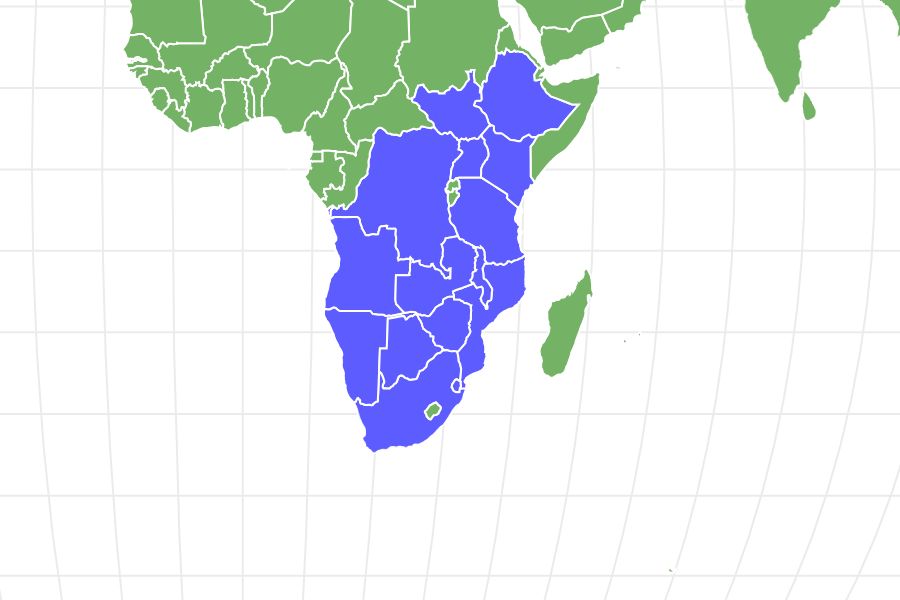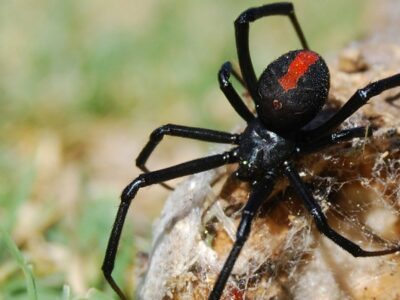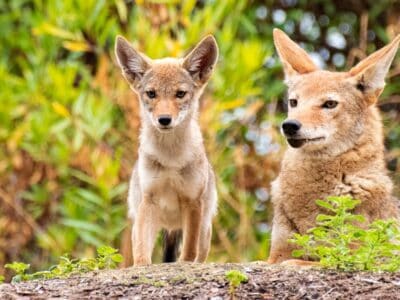Eland
Taurotragus oryx
Both females and males have horns.
Advertisement
Eland Scientific Classification
- Kingdom
- Animalia
- Phylum
- Chordata
- Class
- Mammalia
- Order
- Artiodactyla
- Family
- Bovidae
- Genus
- Taurotragus
- Scientific Name
- Taurotragus oryx
Read our Complete Guide to Classification of Animals.
Eland Conservation Status
Eland Facts
- Name Of Young
- Calf
- Group Behavior
- Herd
- Fun Fact
- Both females and males have horns.
- Estimated Population Size
- 136,000
- Biggest Threat
- Overhunting and habitat destruction
- Most Distinctive Feature
- Horns and dark markings on body.
- Other Name(s)
- Common eland, giant eland.
- Gestation Period
- 274 days
- Litter Size
- 1-2 calves
- Habitat
- Grasslands, woodlands, mountains, and savannas.
- Predators
- Lions, African wild dogs, spotted hyenas, cheetahs.
- Diet
- Herbivore
- Type
- Mammal
- Common Name
- Eland
- Number Of Species
- 1
- Location
- Africa
Eland Physical Characteristics
- Color
- White
- Tawny
- Skin Type
- Fur
- Top Speed
- 25 mph
- Lifespan
- 15-20 years
- Weight
- 660 – 2,650 lbs.
- Height
- 4.3 – 9.5 feet
- Age of Sexual Maturity
- 2 years
- Age of Weaning
- 4 – 6 months
The spiral-horned eland is one of the biggest antelope species of Africa, displaying tawny colors with black markings throughout their body.
Identification of this species over other antelope species can be difficult, but their spiral horns are a dead giveaway. Between the genders, females boast the biggest horns at up to 27 inches long. This horned beast is not aggressive, living amongst over 500 others in their large, migratory herds.
4 Amazing Eland Facts
- Identification of the eland is difficult to discern from other antelope species. However, they are the largest among them, beaten only by the kudu.
- The average lifespan of eland is 15-20 years. When it captivity, some records indicate that they can live up to 25 years comfortably.
- They have some of the biggest horns seen on an antelope species, reaching up to 26 inches long. Though the females are smaller in every sense, they actually can reach up to 27 inches long with their horns.
- These spiral-horned mammals are not aggressive. In fact, males don’t even become competitive or hostile during mating because there is little competition.
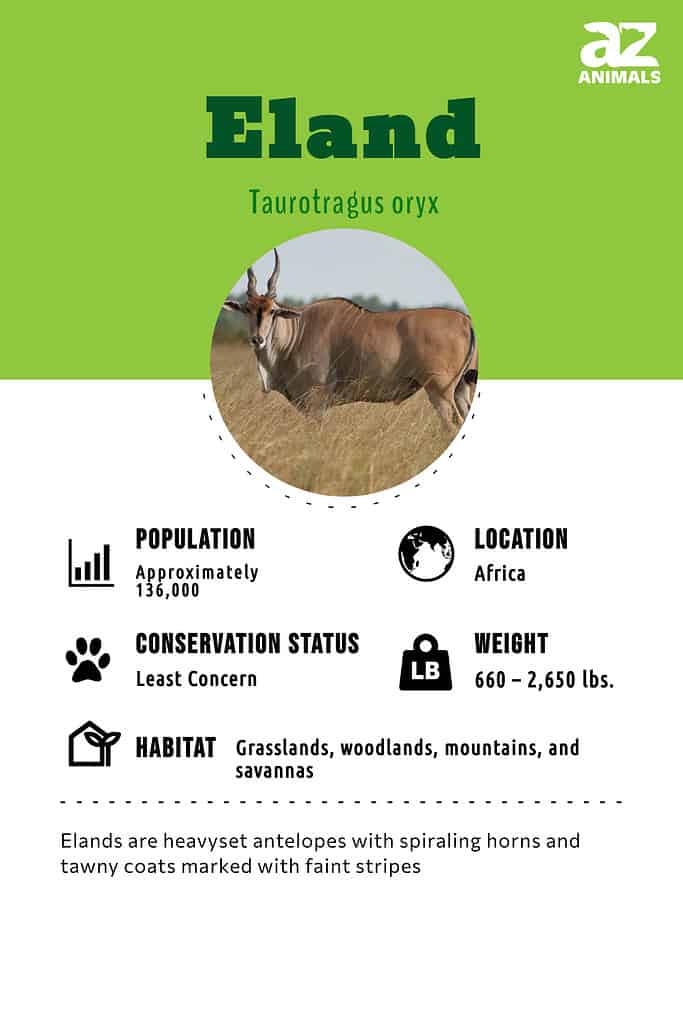
Scientific Name
The scientific name of the eland is Taurotragus oryx. It belongs to the Bovidae family of the Mammalia class. Eland is broken down into two main subspecies – the common eland and the giant eland.
This name is comprised of three main words – tauros, tragos, and oryx. The meanings are mixed in Latin and Greek language. Tauros is the word for a bull, while tragos means goat. Oryx stems from late Middle English and Greek’s “orux,” which is a stonemason’s pickax. It is likely that “oryx” is a reference to the eland’s horns.
Evolution
During the early part of the Miocene, about 20 million years ago, the ancestors of the eland emerged on the evolutionary scene. About 14 million years ago, toward the end of the epoch, the Tragelaphini appeared. During the Pleistocene era, the bovid that would give rise to the common eland roamed northern Tanzania; it was known as Taurotragus arkelli. Scientists have found fossil evidence of early elands dating back to about 11,000 years ago, during the Holocene, in North Africa.
As members of the Tragelaphini, elands are also cousins of bongos and kudus (lesser and greater) which they bear a close resemblance to. They are also related to other members of the genus which include bushbuck, nyala, mountain nyala, and the sitatunga. It is also worth noting that elands are actually more closely related to cows.
Appearance
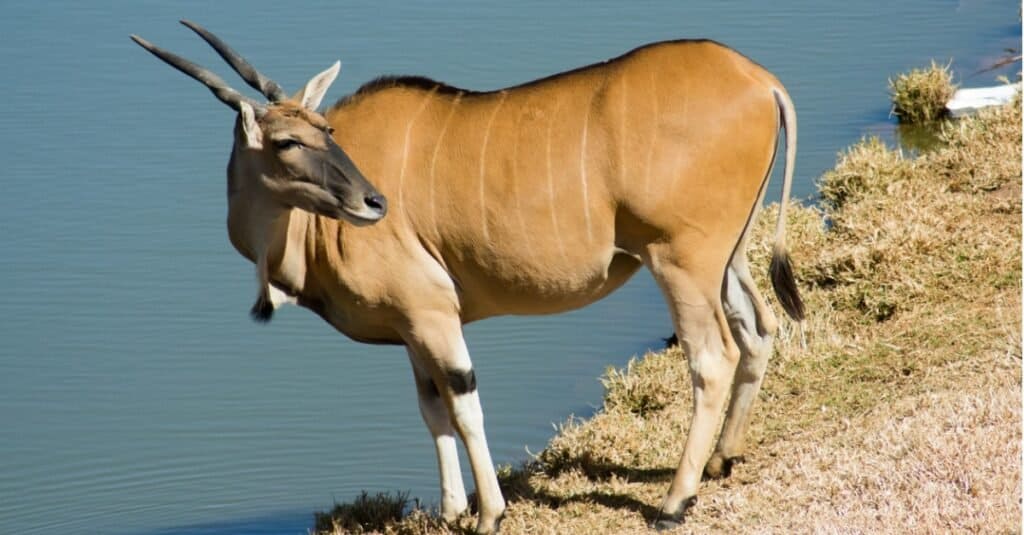
Elands have light-colored coats marked with vertical stripes which can enable them to blend into their surroundings
©iStock.com/Mohammad Ikhtiar Sobhan
The tawny body of the eland helps it camouflage against arid savannas, while the 12 white stripes give more realistic colors to the area. They have multiple dark markings along their body. They have some of the biggest horns of any antelope, beaten only by the kudu. This spiral-horned antelope species features horns on both the females and males and they are one of the biggest antelopes in the world, standing at nearly 9.5 feet tall (among larger males).
Females tend to weigh a little less than males, ranging from 660 lbs. to 1,300 lbs. Males, on the other hand, weigh approximately 880 to over 2,100 lbs. Though they are able to trot away from predators, they don’t have any physical characteristics beyond camouflage to help them.
Eland vs. Kudu
Though the eland and kudu are both dominant antelope species in Africa, you’ll find that proper identification reveals they are not the same animal. The kudu is much taller and heavier, but they are much lankier. One of the telltale signs of the kudu instead of the eland is the presence of a beard on males, though the colors between the species are quite similar.
Behavior
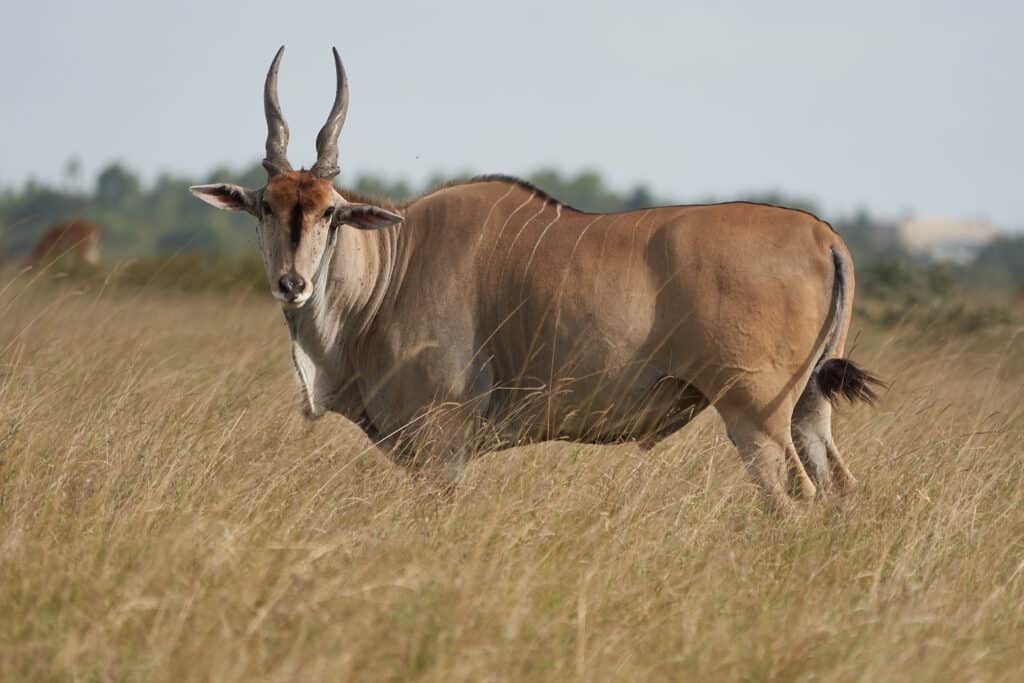
Elands are highly social animals and live in herds which may consist of hundreds of animals
©Rocchas/Shutterstock.com
Elands live in a group with other eland called a herd, which can include up to 500 animals. Despite their large numbers, they aren’t territorial or aggressive, even among males during the breeding season. They tend to roam from place to place, rather than securing a single spot as their own. When they need to rest, they find sheltered areas in their large home range in Africa.
Habitat
The best habitat for eland is one with plenty of food, and they’ll travel a great distance to find it. They seem to adapt well to many areas, including woodlands, grasslands, and savannas. They graze on the land within a herd, though they will separate by males and females.
The two subspecies of eland thrive in different areas of Africa exclusively. The common eland prefers the climate in eastern and southern regions, while the giant eland thrives in central and western areas. They migrate seasonally to seek out food, and they can go long spans of time without water because they retain hydration so well.
Diet
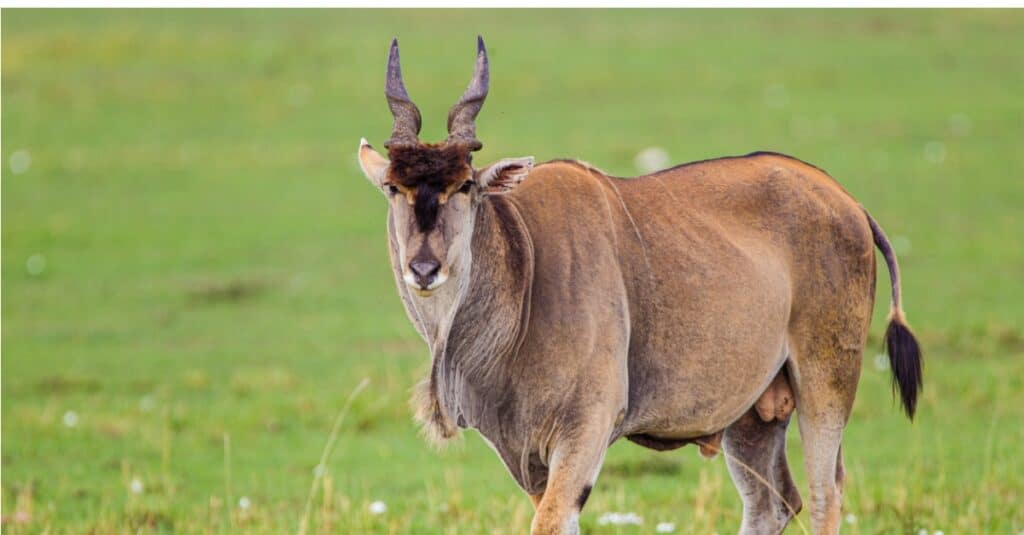
Elands prefer the leaves of flowering plants although they also eat shrubs, grasses, and seeds
©iStock.com/Wayne Marinovich
The diet of an eland is primarily made up of high-protein plants. The preferred food of this antelope species is the leaves of flowering plants, but they aren’t picky. They typically go for whatever happens to be available, allowing them to indulge in the leaves from shrubs, trees, grasses, and seeds. To maintain hydration, this device will also increase its natural temperature, allowing them to use low-quality plants as part of their diet.
Predators and Threats
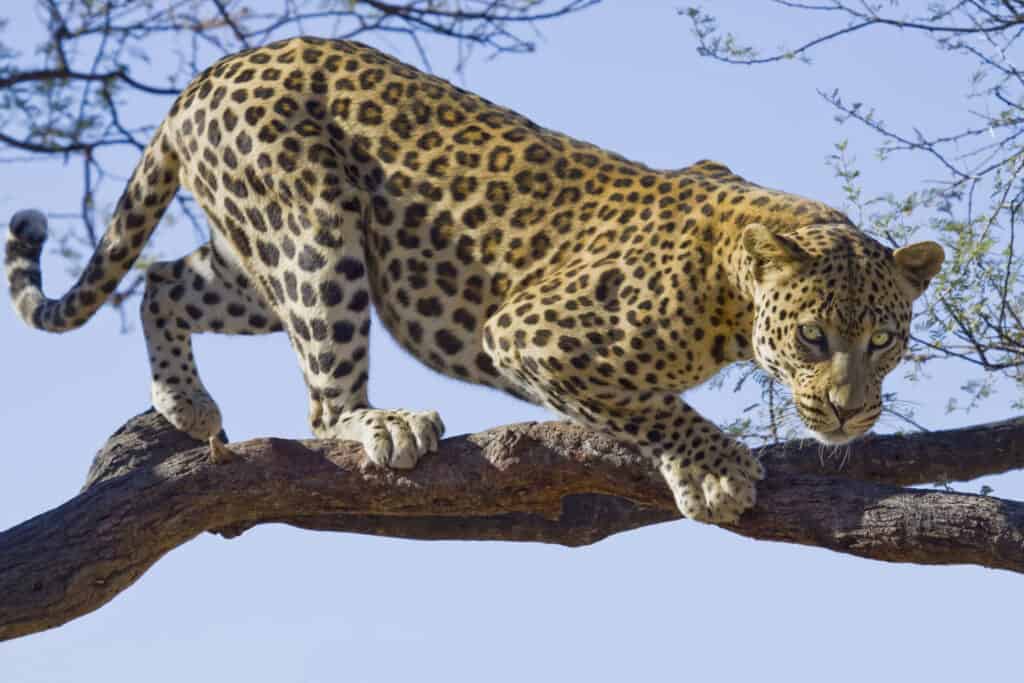
Leopards are just one of several species which prey on elands
©iStock.com/lightstock
Elands are herbivores, so they don’t go after prey of any kind. However, their substantial meat makes them an essential part of the food chain with multiple predators.
While mothers protect their young from predators with their horns, these animals mostly defend themselves from predators with their agility and ability to continue trotting indefinitely. Even though they cannot run more than 25 miles per hour, they can scale up to a 2-meter fence, and they don’t show much fear for potential predators.
What Eats Eland?
Even though they are the biggest antelope species in the world, they are the ideal meal for many large predators. Some of the typical predators that make them a part of their diet include lions, leopards, spotted hyenas, and wild dogs. Due to how large this species is, the only predators that can realistically catch and eat the adults are leopards and spotted hyenas. Other predators primarily go after the calves.
What Do Eland Eat?
Eland doesn’t eat meat, so they don’t have any prey to speak of. Instead, they prefer high-protein leaves and plants that they can graze on comfortably.
Reproduction and Life Cycle

Elands generally live for two decades at the most although they can live longer in captivity
©iStock.com/TT
When elands mate, the male will pursue females in green plains, chasing them to determine if they are ovulating and to test out their urine. Once paired with a mate, the female is pregnant for approximately 274 days, which is just over nine months. They give birth to up to 2 live calves, and females often take multiple partners in their lifetime.
The babies of elands are called calves, and they nurse from their mother for up to six months. The fat in the milk is high, which helps to improve the growth of calves quickly. The mother isn’t on her own to raise her young – she has the help of her entire herd that works as a family.
The average lifespan of the eland is 15-20 years, though elands in captivity are known to live up to 25 years in good conditions.
Population
Currently, there are 136,000 of these animals in the world, and they are primarily found in Africa. The population is steady, and the IUCN has assigned a conservation status of “least concern.”
View all 120 animals that start with EEland FAQs (Frequently Asked Questions)
What is an eland?
The eland is the largest antelope species in the world, shaped much like a cow. It has the ability to jump over a 4-foot-tall fence, and it has incredible endurance while trotting along. Males and females both have horns.
Is an eland bigger than a moose?
Yes! In fact, the eland also has greater speed and strength than the moose. However, the moose stands taller and has a much bigger problem with aggression.
How many species of eland are there?
This antelope species are broken down into two subspecies – the Giant Eland and the Common Eland. While the Giant Eland is found in western and central Africa, the common eland is primarily located from Kenya to Botswana in the eastern and southern regions.
Are eland endangered?
No. The IUCN considers them to be of least concern.
How heavy is an eland?
Both species of eland are typically 660 – 2,650 lbs. Females are smaller than males by over 100 lbs. at their lowest weight.
Is eland good to eat?
Yes. Russian and South African cuisine includes both the milk and meat of this species as a major source of nutrients. It is often treated the same as other cattle.
Are eland carnivores, herbivores, or omnivores?
They are herbivorous.
What are the differences between the Kudu and the Eland?
Two species of kudus exist within the genus Tragelaphus: the lesser kudu (Tragelaphus imberbis) and the greater kudu (Tragelaphus strepsiceros). Likewise, two species of elands exist within the genus Taurotragus: the common eland (Taurotragus oryx) and the giant eland (Taurotragus derbianus). The key differences between kudus and elands are habitat, size, appearance, reproduction, and behavior.
Thank you for reading! Have some feedback for us? Contact the AZ Animals editorial team.
Sources
- ITIS / Accessed February 2, 2022
- Wikipedia / Accessed February 2, 2022
- Bwindi Forest / Accessed February 2, 2022
- Wikipedia / Accessed February 2, 2022
- Safari Bookings / Accessed February 2, 2022
- Kidadl / Accessed February 2, 2022
- African Wildlife Foundation / Accessed February 2, 2022
- San Diego Zoo / Accessed February 2, 2022

